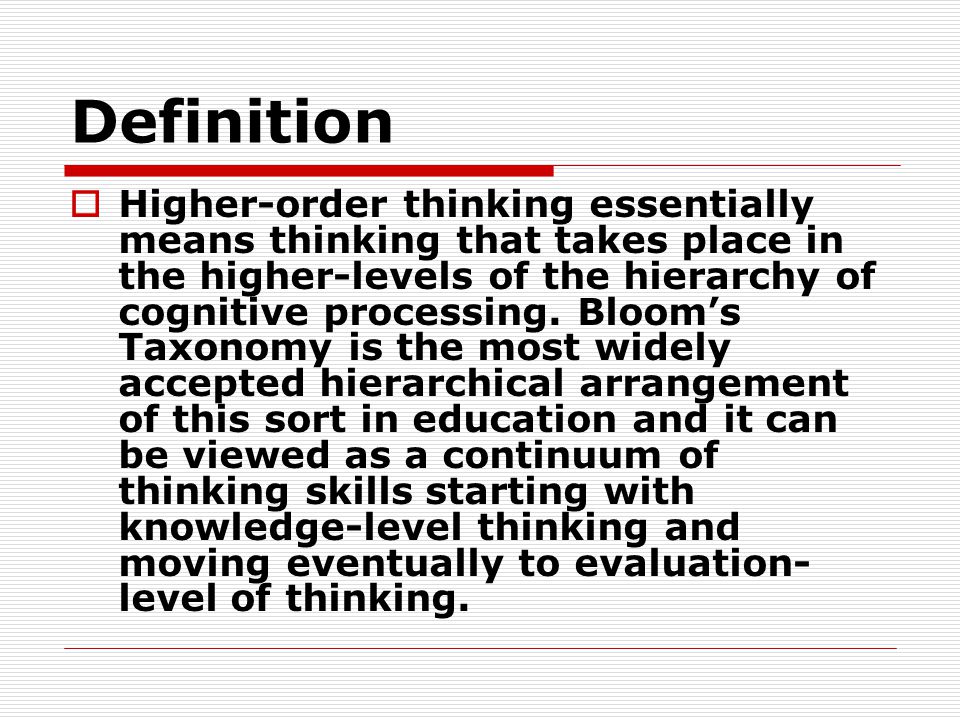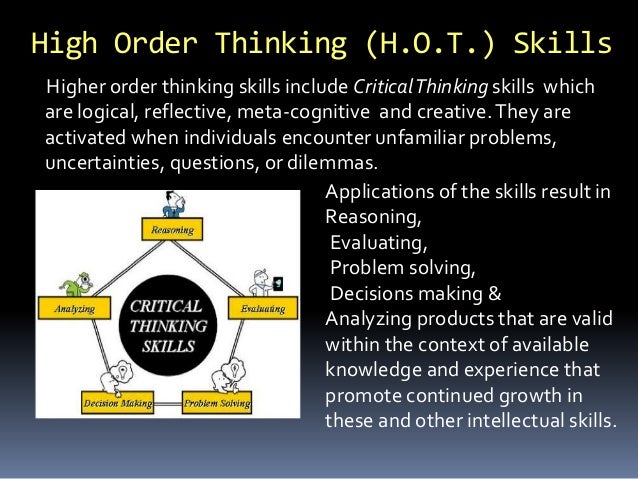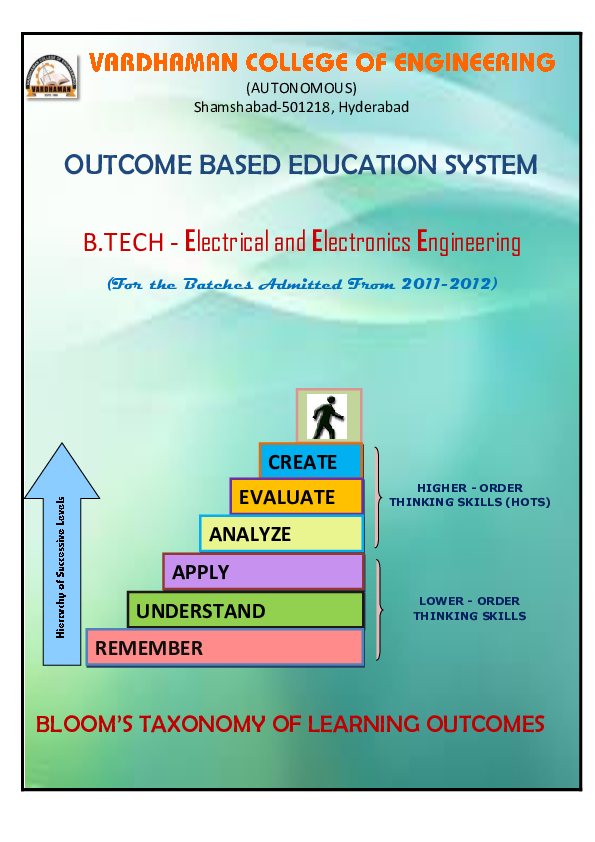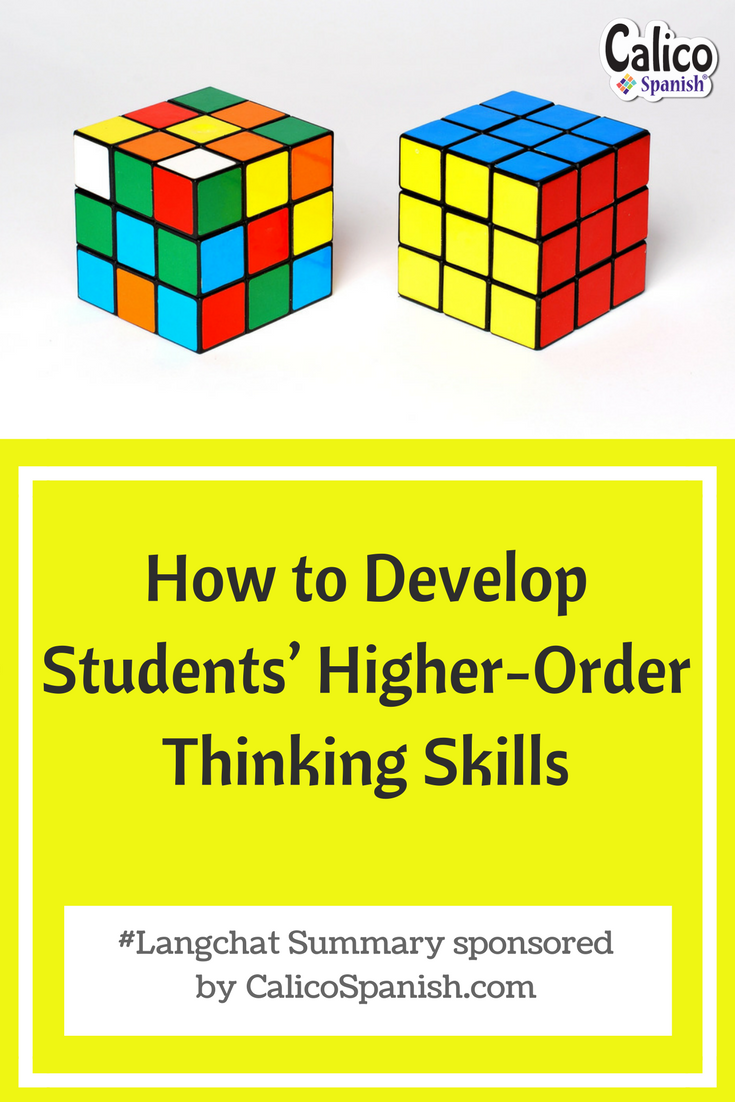High Order Thinking Skill
 Higher Order Thinking Skills Ppt Video Online Download
Higher Order Thinking Skills Ppt Video Online Download
What Is the HOTS Concept in American Education Reform?

Higher-order thinking skills (HOTS) is a concept popular in American education. It distinguishes critical thinking skills from low-order learning outcomes, such as those attained by rote memorization. HOTS include synthesizing, analyzing, reasoning, comprehending, application, and evaluation.
Bloom's taxonomy is taught in a majority of teacher-education programs in the United States. As such, it may be among the most well-known educational theories among teachers nationally. As the Curriculum & Leadership Journal notes:
"While Bloom’s Taxonomy is not the only framework for teaching thinking, it is the most widely used, and subsequent frameworks tend to be closely linked to Bloom’s work.... Bloom’s aim was to promote higher forms of thinking in education, such as analyzing and evaluating, rather than just teaching students to remember facts (rote learning)."
Bloom’s taxonomy was designed with six levels to promote higher-order thinking. The six levels were: knowledge, comprehension, application, analysis, synthesis, and evaluation. (The taxonomy's levels were later revised as remembering, understanding, applying, analyzing, revising, and creating.) The lower-order thinking skills (LOTS) involve memorization, while higher-order thinking requires understanding and applying that knowledge.
The top three levels of Bloom's taxonomy—which is often displayed as a pyramid, with ascending levels of thinking at the top of the structure—are analysis, synthesis, and evaluation. These levels of the taxonomy all involve critical or higher-order thinking. Students who are able to think are those who can apply the knowledge and skills they have learned to new contexts. Looking at each level demonstrates how higher-order thinking is applied in education.
Analysis, the fourth level of Bloom's pyramid, involves students use their own judgment to begin analyzing the knowledge they have learned. At this point, they begin understanding the underlying structure of knowledge and also are able to distinguish between fact and opinion. Some examples of analysis would be:
- Analyze each statement to decide whether it is fact or opinion.
- Compare and contrast the beliefs of W.E.B. DuBois and Booker T. Washington.
- Apply the rule of 70 to determine how quickly your money will double at 6 percent interest.
- Illustrate the differences between the American alligator and the Nile crocodile.
Synthesis, the fifth level of Bloom’s taxonomy pyramid, requires students to infer relationships among sources, such as essays, articles, works of fiction, lectures by instructors, and even personal observations. For example, a student might infer a relationship between what she has read in a newspaper or article and what she has observed herself. The high-level thinking of synthesis is evident when students put the parts or information they have reviewed together to create new meaning or a new structure.
At the synthesis level, students move beyond relying on previously learned information or analyzing items that the teacher is giving to them. Some questions in the educational setting that would involve the synthesis level of higher-order thinking might include:
- What alternative would you suggest for ___?
- What changes would you make to revise___?
- What could you invent to solve___?
Evaluation, the top level of Bloom's taxonomy, involves students making judgments about the value of ideas, items, and materials. Evaluation is the top level of Bloom’s taxonomy pyramid because at this level that students are expected to mentally assemble all they have learned to make informed and sound evaluations of the material. Some questions involving evaluation might be:
- Evaluate the Bill of Rights and determine which is the least necessary for a free society.
- Attend a local play and write a critique of the actor’s performance.
- Visit an art museum and offer suggestions on ways to improve a specific exhibit.
Children with learning disabilities can benefit from educational programming that includes HOTS. Historically, their disabilities engendered lowered expectations from teachers and other professionals and led to more low-order thinking goals enforced by drill and repetition activities. However, children with learning disabilities can develop the higher-level thinking skills that teach them how to be problem solvers.
Traditional education has favored the acquisition of knowledge, especially among elementary school-age children, over the application of knowledge and critical thinking. Advocates believe that without a basis in fundamental concepts, students cannot learn the skills they will need to survive in the work world.
Reform-minded educators, meanwhile, see the acquisition of problem-solving skills—higher-order thinking—to be essential to this very outcome. Reform-minded curricula, such as the Common Core, have been adopted by a number of states, often amid controversy from traditional education advocates. At heart, these curricula emphasize HOTS, over strict rote memorization as the means to help students achieve their highest potential.
Gallery High Order Thinking Skill
Higher Order Thinking Schools Theory Into Practice
 Computer And Higher Order Thinking Skills Edward Vockell
Computer And Higher Order Thinking Skills Edward Vockell
 Hots Higher Order Thinking Skills Miss Francine S Website
Hots Higher Order Thinking Skills Miss Francine S Website
 Scaling Up Higher Order Thinking Skills And Personal
Scaling Up Higher Order Thinking Skills And Personal
 Higher Order Thinking Skills Template Higher Order
Higher Order Thinking Skills Template Higher Order
 Teaching Higher Order Thinking 21st Century Skills
Teaching Higher Order Thinking 21st Century Skills
Teaching Strategies That Enhance Higher Order Thinking
Higher Order Thinking Skills Ppt Video Online Download
 Pdf Higher Order Thinking Skills Hots Lower Order
Pdf Higher Order Thinking Skills Hots Lower Order
 Introduction Higher Order Thinking Skills In Maths
Introduction Higher Order Thinking Skills In Maths
 Creating Tests That Assess Higher Order Thinking Skills
Creating Tests That Assess Higher Order Thinking Skills
 Higher Order Thinking Skills Hots Education
Higher Order Thinking Skills Hots Education
 What Is Higher Order Thinking What Does Higher Order Thinking Mean
What Is Higher Order Thinking What Does Higher Order Thinking Mean
 Pdf The Level Of Marzano Higher Order Thinking Skills Among
Pdf The Level Of Marzano Higher Order Thinking Skills Among
 Strategies For Developing Higher Order Thinking Skills Grades 6 12
Strategies For Developing Higher Order Thinking Skills Grades 6 12
 Higher Order Thinking Skills Hots Infused In Engineering
Higher Order Thinking Skills Hots Infused In Engineering
 Enhancing Students Higher Order Thinking Skills Hots Via
Enhancing Students Higher Order Thinking Skills Hots Via
 Can You Take Me Higher Building Higher Order Thinking
Can You Take Me Higher Building Higher Order Thinking
 How To Develop Students Higher Order Thinking Skills From
How To Develop Students Higher Order Thinking Skills From
 These Bloom S Analysis Tools Are Perfect For Higher Order
These Bloom S Analysis Tools Are Perfect For Higher Order
 Influence Of Explicit Higher Order Thinking Skills
Influence Of Explicit Higher Order Thinking Skills
0 Response to "High Order Thinking Skill"
Post a Comment